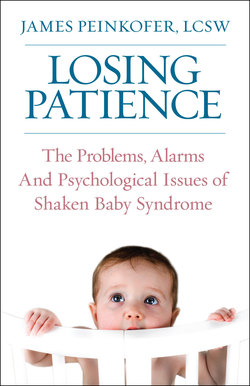Читать книгу Losing Patience - James Peinkofer - Страница 8
На сайте Литреса книга снята с продажи.
ОглавлениеIntroduction
I will always remember where I was and how I felt when I read my first medical journal article on Shaken Baby Syndrome. I was in the cafeteria of the hospital where I was a pediatric social worker. Our hospital got a few child abuse cases each month, but the hospital on the other side of town seemed to be the primary center for child welfare cases. I had not experienced having a shaken baby within our hospital walls—yet. I had only been in pediatrics for several months. I had pushed for this position, since I had an infant son myself. I wanted to jump into the world of caring for babies—the good and the bad—feet first.
The article “Shaken Baby Syndrome” by Richard Spaide and his team was, for me, a shocking clinical exposé on the dark world into which I was about to launch myself. It was the morning of a bright summer day when I sat in the hospital’s cafeteria alone to read the article. Spaide’s paper initially discussed the history of the syndrome and then delved into the physiology of the infant brain: its soft, gelatin-like consistency, its nerves and veins loosely attached. The author then described how he believed an actual shaking event occurred.1 What Spaide detailed sickened me.
I remember pausing to put the pages down on the table in front of me, in order to reflect and to distance myself from the violence. I couldn’t believe that such brutality was possible, that it was truly possible for men and women to do such a horrible thing to a tiny human being who was so vulnerable. After I finished reading this article, I read hundreds more in the years ahead. I also experienced real-life events brought on by shaking abuse. I came to see the dark side of caregiving. Over the years, I built emotional armor to wear. The armor was my professional protection for myself, my shield as I looked people in the eye who could be lying to me about shaking their baby.
